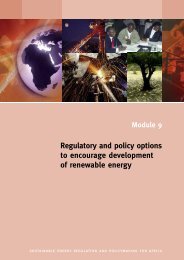Increasing access to energy services in rural areas - REEEP ...
Increasing access to energy services in rural areas - REEEP ...
Increasing access to energy services in rural areas - REEEP ...
Create successful ePaper yourself
Turn your PDF publications into a flip-book with our unique Google optimized e-Paper software.
MODULE 10: INCREASING ACCESS TO ENERGY SERVICES IN RURAL AREAS<br />
page 10.19<br />
6. POLICY OPTIONS FOR INCREASING<br />
ACCESS TO ENERGY SERVICES IN<br />
RURAL AREAS<br />
6.1. Basic needs of <strong>energy</strong> <strong>in</strong> <strong>rural</strong> <strong>areas</strong> 34<br />
The benefits deriv<strong>in</strong>g from <strong>energy</strong> <strong>services</strong> are often diverse and complex. They<br />
range from:<br />
• The direct benefits of contribut<strong>in</strong>g <strong>to</strong> <strong>in</strong>creased production and reduc<strong>in</strong>g “sweat<br />
<strong>energy</strong>”;<br />
• The contribution that <strong>energy</strong> can make <strong>to</strong> health and human capital, for example<br />
<strong>in</strong> terms of pump<strong>in</strong>g water or provision of light<strong>in</strong>g and other <strong>services</strong> <strong>to</strong><br />
health facilities and schools;<br />
• More <strong>in</strong>tangible benefits of “security” (via street light<strong>in</strong>g, back-up <strong>energy</strong> supplies,<br />
or pumped water reduc<strong>in</strong>g risks from drought);<br />
• A sense of “<strong>in</strong>clusion” <strong>in</strong> the modern economy (via communications media).<br />
These basic needs and <strong>energy</strong> sources are listed <strong>in</strong> table 2 below.<br />
A wide range of devices convert primary sources of <strong>energy</strong> <strong>in</strong><strong>to</strong> various “<strong>services</strong>”<br />
but this process always has a cost (both for conversion processes and because<br />
of efficiency losses). The cost of “useful <strong>energy</strong>” can be quite different from the<br />
cost of the “primary <strong>energy</strong>” or fuel. Therefore it is important <strong>to</strong> refer <strong>to</strong> the provision<br />
of <strong>energy</strong> <strong>services</strong> rather than merely the supply of <strong>energy</strong>.<br />
It is important <strong>to</strong> note that as people become richer and proceed through the<br />
“<strong>energy</strong> transition” that <strong>in</strong>troduce new, more convenient and efficient sources of<br />
<strong>energy</strong> <strong>in</strong><strong>to</strong> their lives, they may well cont<strong>in</strong>ue us<strong>in</strong>g the traditional <strong>energy</strong> sources<br />
as well. This is <strong>in</strong> part for cultural reasons and <strong>in</strong> part <strong>to</strong> m<strong>in</strong>imize the risk of <strong>in</strong>terruption<br />
<strong>in</strong> supply (for example back-up diesel genera<strong>to</strong>r <strong>to</strong> cover the risk of cuts<br />
<strong>in</strong> power from the electricity grid). This multiple fuel use means that the impact<br />
of fuel switch<strong>in</strong>g and efficiency improvements is often not as substantial as models<br />
and policies might predict.<br />
This is perhaps at its most extreme with cook<strong>in</strong>g, where households may graduate<br />
<strong>to</strong> LPG but women still use wood and charcoal <strong>to</strong> cook certa<strong>in</strong> types of food.<br />
Even very poor households may reta<strong>in</strong> a variety of options <strong>to</strong> reduce the costs or<br />
34<br />
EnPoGen Report, Energy, Poverty and Gender: a Review of the Evidence and Case Studies <strong>in</strong> Rural<br />
Ch<strong>in</strong>a, 2003.










